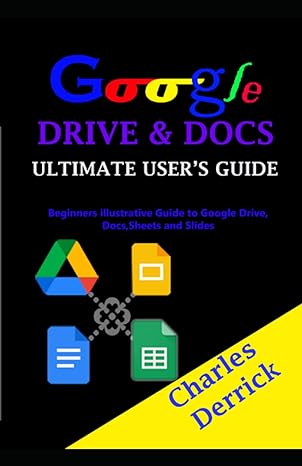Question
Create mapper and reducer files in python: On many social media websites, it is common for the company to provide a list of suggested contacts
Create mapper and reducer files in python: On many social media websites, it is common for the company to provide a list of suggested contacts for you to connect with. Many of these suggestions come from your own list of current contacts. The basic idea behind this concept being: I am connected with person A and person B but not person C. Person A and person B are both connected to person C. None of my contacts are connected to person D. It is more likely that I know person C than some other random person D who is connected to no one I know. For this problem, all connections are mutual (i.e. if A is connected to B, then B is connected to A). In this problem, you will read in an input file that is delimited in the following manner:
PersonA : PersonX PersonY PersonZ PersonQ
PersonB : PersonF PersonY PersonX PersonG PersonM
For example, the person to the left of the colon will be the current person. All people to the right of the colon are the people that the current person is connected to. All people will be separated by a single space. In the example above, PersonA is connected to PersonX, Y, Z and Q. In all inputs, all people will be replaced with positive integer ids to keep things simple. The following is a sample input file:
6 : 2 9 8 10
1 : 3 5 8 9 10 12
4 : 2 5 7 8 9
2 : 3 4 7 6 13
12 : 1 7 5 9
3 : 9 11 10 1 2 13
10 : 1 3 6 11
5 : 4 1 7 11 12
13 : 2 3
8 : 1 6 4 11
7 : 5 2 4 9 12
11 : 3 5 10 8
9 : 12 1 3 6 4 7
The ordering of people on the right hand side of the input can be in any order. Your goal is this: you must output potential contacts based on the following 2 criteria:
- Someone who might be someone you know. For someone to be suggested here, the person must not currently be a connection of yours and that person must be a connection of exactly 2 or 3 of your current connections. For example, consider person 2 in the above example. Person 2 is connected with 3, 4, 6, 7 and 13. Person 4 is connected to 8, person 6 is connected to 8, person 3 is not connected to 8, person 7 is not connected to 8 and person 13 is not connected to 8. Therefore, person 2 has two connections (4 and 6) that are connected to 8 and person 2 is not currently connected to 8. Therefore, person 2 might know person 8.
- Someone you probably know. For someone to be suggested here, the person must not currently be a connection of yours and that person must be a connection of 4 or more of your current connections. For example, consider person 2 in the above example. Person 2 is connected with 3, 4, 6, 7 and 13. Person 4 is connected to 9, person 6 is connected to 9, person 3 is connected to 9 and person 7 is connected to 9. Therefore, person 2 has at least four connections that are connected to 9 and person 2 is not currently connected to 9. Therefore, person 2 probably knows person 9.
Your output must be formatted in the following fashion:
personID:Might(personA,,personX) Probably(personA,personX)
For each line you have a personID following by a colon. The colon is followed by the list of Mights separated by commas (but no space). If a person has no one they might be connected to, this list is not printed at all (see person 13 below for example). The Might list is followed by a single space and then followed by the Probably list separated by commas (but no space). If a person has no one they probably are connected to, this list is not printed at all (see person 3 for example). If a person has neither a might list nor a probably list, that person only has their id along with a colon (see person 13 for example). The Might list must appear before the Probably list. If there is no Might list but there is a Probably list, there is no space between the colon and the Probably list. The integers within each list must appear in increasing order. However, the order the rows appear in the output need not be in any specific order. For example, the row for 5 might appear before the row for 3. As a concrete example from the above sample input, this would be a potential sample output:
1:Might(4,6,7) Probably(11)
2:Might(5,8,10) Probably(9)
3:Might(4,5,6,7,8,12)
4:Might(1,3,6,11,12)
5:Might(2,3,8,10) Probably(9)
6:Might(1,3,4,7,11)
7:Might(1,3,6)
8:Might(2,3,5,9,10)
9:Might(8,10) Probably(2,5)
10:Might(2,5,8,9)
11:Might(4,6) Probably(1)
12:Might(3,4)
13:
For each question, the rows do not have to be in any specific order. The following is also a valid output for number 3:
9:Might(8,10) Probably(2,5)
1:Might(4,6,7) Probably(11)
3:Might(4,5,6,7,8,12)
4:Might(1,3,6,11,12)
5:Might(2,3,8,10) Probably(9)
11:Might(4,6) Probably(1)
6:Might(1,3,4,7,11)
7:Might(1,3,6)
2:Might(5,8,10) Probably(9)
8:Might(2,3,5,9,10)
10:Might(2,5,8,9)
12:Might(3,4)
13:
Step by Step Solution
There are 3 Steps involved in it
Step: 1

Get Instant Access to Expert-Tailored Solutions
See step-by-step solutions with expert insights and AI powered tools for academic success
Step: 2

Step: 3

Ace Your Homework with AI
Get the answers you need in no time with our AI-driven, step-by-step assistance
Get Started


